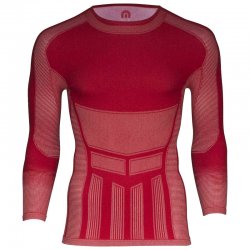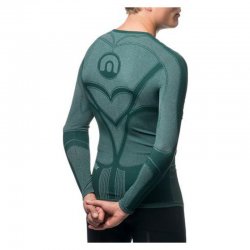Megmeister's Drynamo Long Sleeve Crew
Preface
As always, we're looking at the Megmeister Drynamo Crew from the point of view of long distance trekking over tough terrain.
Note (October 2024): The latest versions of the Drynamo Crew feature thumb loops.
Test subject: Chest 42", Waist 33", Height: 5ft 8"
Test item: Size = Large (see sizing below)
Kit Tests: Summer (plus shorter Spring / Autumn mini-tests)
Disclaimer: None required (item not provided by manufacturer)
Datasheet
| Materials: Polypropylene Dryarn / Nylon 6.6 / Elastane | 44% / 44% / 12% |
| Weight (measured - Size Large) | 188g |
| Product Sizing Reference: 42" Chest = | Large |
| Manufacturer RRP | £70.00 |
| Scramble's Price on SYSTEM | £52.50 |
Scramble Review
Contents
- Introduction
- Ever Since HH Gave Up The Ghost
- "Summer" Kit Test
- Size, Fit & Feel
- Design & Performance
- Any Negatives?
- Conclusion & Rating
- Postscript: Why Polypropylene?
Introduction: Thermo-Regulation
The purpose of a baselayer is to move moisture and excess heat away from the skin and achieve a thermal balance that doesn't fluctuate too much throughout the day as conditions and activity levels vary.
"The closer the fabric the better the transfer of heat. Isn’t that a bad thing? No, the faster you can achieve thermal equilibrium with your base layers the less swift conduction will take place and a perfect micro climate can be achieved. This close layer will be highly efficient at stabilizing and re-establishing equilibrium if the user gets too hot or too cold and, gram for gram, will outperform a thicker but baggier inefficient layer. This is why a tight wetsuit is better than a baggy wet suit, even though both are full of potentially heat-sapping moisture. Stretch base layers are best, but most modern base layers are undermined by being too loose, being cut in order to pass as casual pieces." - Andy Kirkpatrick (mountaineer)
Ever Since HH Gave Up The Ghost
Ever since Helly Hansen gave up on their excellent Dry Revolution (later Dry Elite 2.0) form-hugging (non-winter) baselayers, we've been looking for a successor and in the Megmeister Drynamo we've finally found one.
I can only assume this type of baselayer is not popular enough to warrant the attention of many of the all-too-fashion-conscious outdoor brands (who seem increasingly pre-occupied with what will work on the cat-walk or the high-street rather than what might actually function in the mountains). Few people (and I'm not one of them) look great in this kind of apparel, but for a baselayer to actually function, a close fit is required.
As we outlined in our baselayer shorts review, if we were designing this type of garment our choice of materials would be "Polypropylene for its light weight, hydrophobic, thermal, and many other qualities (see below); Polyamide (Nylon) for its toughness and to aid compression and a decent helping of Elastane to provide the necessary stretch for a fitted baselayer". This is exactly what Megmeister have used in their Drynamo series.
Designed in Holland and manufactured in Italy, the Drynamo is put together using a patented machine weave construction that results in creating each garment from one piece of fabric that is then cut from the machine and bonded together seamlessly. The Drynamo, pleasingly, comes free of labels or any other annoyances that might compromise the comfort of the wearer. All in all, a high quality product.
 A close fit and the right mix of materials
A close fit and the right mix of materials
"Summer" Kit Test
The Drynamo got its last run-out in our recent 2019 Summer Kit Test. Due to a busy schedule this was delayed and rather than beginning in July it took place late August into early September, spanning south to north Wales. The weather was wet, unseasonably cold and at times extremely windy; when there were blue skies it was hot in the sun, cold in the shade. Overall it was a good examination of light-weight gear in sometimes "heavy-weight" weather.
Unlike most summer kit tests, where I've worn a baselayer only during the cooler times of day (up until around 10am, then perhaps some time after 5pm), on this 10 day trek (hard slog) it was on from dawn to dusk, always beneath a zipped tee (and often beneath a lightweight softshell and waterproof too).
Size, Fit & Feel
A couple of things are immediately evident when first putting on the Drynamo. Compared to baselayers like Odlo's Evolution Light or Helly Hansen's Dry Revolution, Megmeister's Drynamo seems noticeably "spongier", definitely stretchier and pleasingly, longer in the body and in the arm. This extra fabric is partly responsible for the Drynamo weighing around 40g more than the aformentioned layers, though not entirely; the higher than normal elastane (12%) content also adds to the weight, and is presumably responsible for its soft, "spongy" comfort and slightly luxurious feel.
The high elastane content has enabled Megmeister to provide only two sizes (it's pleasing when manufacturers think a little differently - especially when it works); a size small (covering what would traditionally be XS to M) and a large (covering M to XL). The only issue would be for those who fall precisely at the mid-point (39" chest) and here I would choose the smaller size.
Over the recent 10 day test, it was noticeable how well the Drynamo kept its shape. Often baselayers we've tested have become noticeably baggier by the end of the trek. The rebound provided by the high elastane content is excellent.
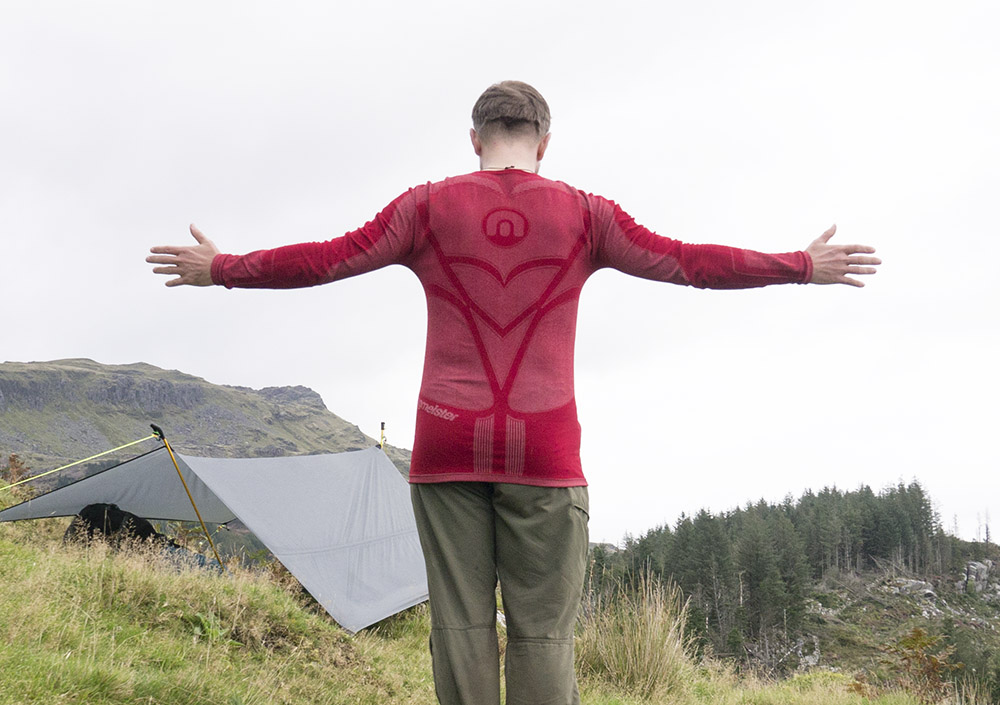 Long in the body and not short in the arm, the Drynamo keeps its shape superbly
Long in the body and not short in the arm, the Drynamo keeps its shape superbly
Design & Performance
My concern prior to using the Drynamo, was that it was going to be too warm, but in use this was not the case at all. Even on the hottest days (there were a couple), at the hottest time of day, I was able to keep the Drynamo on without overheating. This is where Megmeister have got things just right; too much polypropylene would have made it too warm for summer use, but having a 1:1 ratio of polypropylene to nylon reduces the insulation without sacrificing the hydophobic wicking properties which nylon (to a lesser degree) and polypropylene both share. In addition the extra nylon makes the layer tougher and no doubt longer lasting.
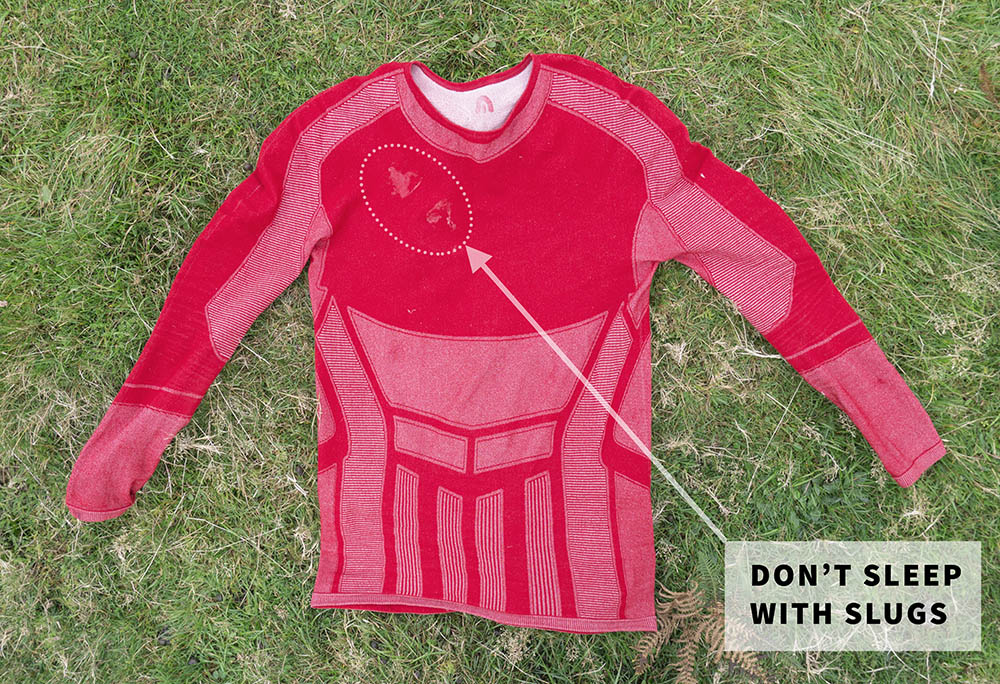 Good ventilation on the shoulders and at the wrist
Good ventilation on the shoulders and at the wrist
The Drynamo Crew has a pretty funky design and certainly some of this is what I would call "technical aesthetics", but that said the lighter patterns (2 and 3 below) are derived from two distinctly different weaves which when stretched across the body act like pores of varying apertures providing a good degree of ventilation, allowing heat and moisture to escape and keeping the wearer cool and dry.
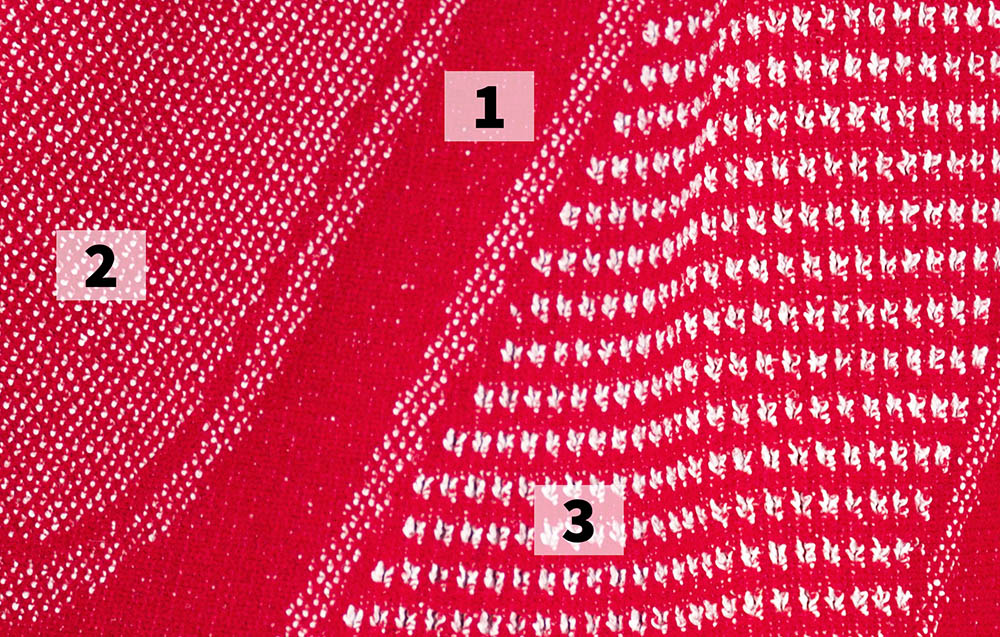 A close-up view of the Drynamo's three weaves
A close-up view of the Drynamo's three weaves
In terms of performance the Drynamo is simply outstanding and as good, possibly even better than Helly Hansen's superb Dry Revolution / Elite 2.0.
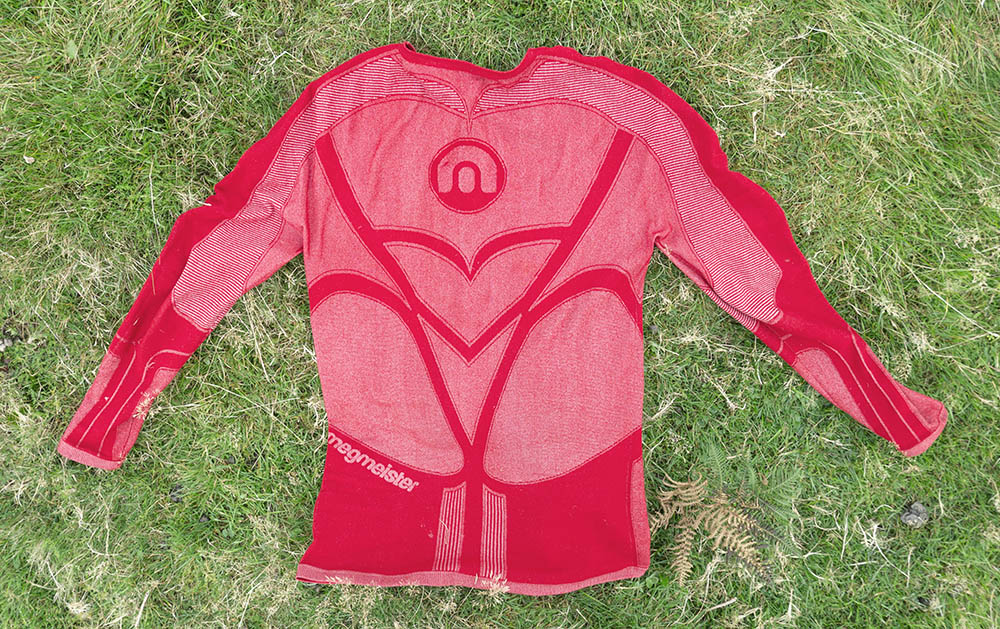 A good deal of ventilation across the back
A good deal of ventilation across the back
Finally, I'd just like to emphasise how good this top is at staying dry. At the end of every day (with one exception, where it literally rained without pause) when getting changed into my sleepwear, I was struck by how dry (often almost bone dry) the Drynamo was.
That one rainy day, because it got a little damp (everything got soaked) I decided to let it air and used it as a pillow on top of my Tower - turns out giant slugs are equally keen on the Drynamo. Don't know why, but something to keep in mind.
I had a sense before testing it, that it might be pretty good, just based on the mix of materials and the seamless technology used and where the product was manufactured, but I had my reservations (as mentioned above). Those reservations have been completely extinguished.
Any Negatives?
There are two inter-related negatives, both derive from the fabric mix: weight and packability.
The Drynamo is about 40g overweight against what we've come to expect from lightweight 3-season baselayers (HH Dry Revolution, was 140g - note its composition was 97% polypropylene 3% elastane - which is why they could make them so light).
Due to its "sponginess", the Drynamo doesn't pack down that small compared to say Odlo, HH or F-Lites etc ... What this means is that the Drynamo makes for a perfect main baselayer to be worn the bulk of the time. If you need to carry a spare (which I always do - as a backup, but also something fresh to wear on the return journey) then I'd recommend F-Lite's polypropylene-based Ultralight 70 long or short sleeved (SS) baselayers (the SS variant in both L and XL weigh under 90g !). They're pretty decent in their own right, pack down really small and are one of the lightest baselayers around. They don't perform as well as the Drynamo, but as backups they're perfect.
Because these are only negatives when packed as a spare we're going to dock just a half a point each from the function and weight scores.
Conclusion & Rating
Since Helly Hansen discontinued their excellent (Dry Revolution / Dry Elite) line of form-hugging, lightweight (3 season) baselayers we've been testing alternatives and in the Megmeister Drynamo have finally found a worthy successor that not only equals but betters the Helly Hansen models.
The Drynamo baselayer is ideal for 3 season use (for cool early morning starts and late evening finishes in summer all the way down to around 0 °C, beyond which a winter baselayer would be more appropriate).
Utilising an ideal mix of materials, Megmeister have made a truly outstanding baselayer: ultra comfortable, form-fitting, with superb rebound (maintaining its shape day in day out). Unphased by changing conditions and activity levels, the Drynamo's heat and moisture management are consistently superb.
The 2019 summer kit test was a real test for any baselayer, with highly variable conditions swinging between cold spring days to soaking wet autumnal weather with something approaching summer briefly blowing in on a gale - chaotic Welsh weather at its finest. The fact that I was able to keep the baselayer on the entire time I was active (12 hours trekking a day), and really not notice it at all, is a testament to its ability to maintain a steady, dry, cool and comfortable micro climate, while slogging through what has to be some of the most challenging undergrowth in the UK.
The Megmeister Drynamo Long Sleeve Crew is most definitely our top pick in the 3 Season Baselayer category.
Now please Megmeister, don't pull a Helly and cease production of a product you've just perfected.
Product Images
Rating (out of 10)
* The value score is derived from two factors:
1) Competitive Market Price (CMP). This represents our judgement of a competitive online price point if we were to stock the item. e.g. if we feel we would need to sell an item at 40% off (i.e. 60% of its full RRP) to be competitive, then our CMP score will be 6/10.
2) Customer Value Price (CVP). We then make an honest appraisal of the maximum price we would be willing to pay for the item (and we're mean). So if we'd pay 80% of its RRP our CVP score would be 8/10.
We then average the two scores to get our final value score, which in our example would be 7/10.
Postscript: Why Polypropylene?
What's so special about Polypropylene? Well, quite a bit ...
From the standpoint of a lightweight baselayer it's hard to envisage a more appropriate material:
- Lightweight: Because of its low specific gravity, polypropylene yields the greatest volume of fibre for a given weight. Polypropylene is the lightest of all fibres and is lighter than water. It is 34% lighter than polyester and 20% lighter than nylon.
- Hydrophobic, thus quick to dry: The water absorption of polypropylene fibre is about 0.3% after 24 hours immersion in water, and thus its regain – the amount of water absorbed in a humid atmosphere – is virtually nil (0.05% at 65% RH, 21 °C.). Being hydrophobic it will not absorb water into the fibre, instead water “wicks” away from the skin and through the fabric to the face for quick evaporation.
- Cold weather performance: Lowest thermal conductivity of any natural or synthetic fibre (6.0 compared to 7.3 for wool, 11.2 for viscose and 17.5 for cotton). Polypropylene fibres retain more heat for a longer period of time providing outstanding insulation and combined with its hydrophobic qualities keeps the wearer dry as well as warm. Polypropylene is warmer than wool, remains flexible at temperatures in the region of -55°C and recovers well from bending.
- Microbially inert: Like other synthetic fibres – nylon, acrylic and polyester – polypropylene fibres are not attacked by bacteria or micro-organisms; they are also moth-proof and rot-proof and are inherently resistant to the growth of mildew and mold.
- Abrasion resistant: The abrasion resistance of polypropylene approaches that of nylon and remains high even when wet.
Last Updated: 28/10/24
We now link back to the new version at SYSTEM (available early December).



